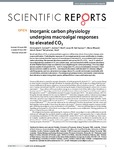Inorganic carbon physiology underpins macroalgal responses to elevated CO2
| dc.contributor.author | Hall-Spencer, Jason | |
| dc.date.accessioned | 2017-04-25T10:39:38Z | |
| dc.date.available | 2017-04-25T10:39:38Z | |
| dc.date.issued | 2017-04-18 | |
| dc.identifier.issn | 2045-2322 | |
| dc.identifier.issn | 2045-2322 | |
| dc.identifier.other | 46297 | |
| dc.identifier.uri | http://hdl.handle.net/10026.1/9116 | |
| dc.description.abstract |
<jats:title>Abstract</jats:title><jats:p>Beneficial effects of CO<jats:sub>2</jats:sub> on photosynthetic organisms will be a key driver of ecosystem change under ocean acidification. Predicting the responses of macroalgal species to ocean acidification is complex, but we demonstrate that the response of assemblages to elevated CO<jats:sub>2</jats:sub> are correlated with inorganic carbon physiology. We assessed abundance patterns and a proxy for CO<jats:sub>2</jats:sub>:HCO<jats:sub>3</jats:sub><jats:sup>−</jats:sup> use (δ<jats:sup>13</jats:sup>C values) of macroalgae along a gradient of CO<jats:sub>2</jats:sub> at a volcanic seep, and examined how shifts in species abundance at other Mediterranean seeps are related to macroalgal inorganic carbon physiology. Five macroalgal species capable of using both HCO<jats:sub>3</jats:sub><jats:sup>−</jats:sup> and CO<jats:sub>2</jats:sub> had greater CO<jats:sub>2</jats:sub> use as concentrations increased. These species (and one unable to use HCO<jats:sub>3</jats:sub><jats:sup>−</jats:sup>) increased in abundance with elevated CO<jats:sub>2</jats:sub> whereas obligate calcifying species, and non-calcareous macroalgae whose CO<jats:sub>2</jats:sub> use did not increase consistently with concentration, declined in abundance. Physiological groupings provide a mechanistic understanding that will aid us in determining which species will benefit from ocean acidification and why.</jats:p> | |
| dc.format.extent | 0-0 | |
| dc.format.medium | Electronic | |
| dc.language | en | |
| dc.language.iso | en | |
| dc.publisher | Springer Science and Business Media LLC | |
| dc.subject | Biodiversity | |
| dc.subject | Carbon | |
| dc.subject | Carbon Dioxide | |
| dc.subject | Ecosystem | |
| dc.subject | Hydrogen-Ion Concentration | |
| dc.subject | Italy | |
| dc.subject | Oceans and Seas | |
| dc.subject | Seawater | |
| dc.subject | Seaweed | |
| dc.title | Inorganic carbon physiology underpins macroalgal responses to elevated CO2 | |
| dc.type | journal-article | |
| dc.type | Journal Article | |
| plymouth.author-url | https://www.webofscience.com/api/gateway?GWVersion=2&SrcApp=PARTNER_APP&SrcAuth=LinksAMR&KeyUT=WOS:000399555200001&DestLinkType=FullRecord&DestApp=ALL_WOS&UsrCustomerID=11bb513d99f797142bcfeffcc58ea008 | |
| plymouth.issue | 0 | |
| plymouth.volume | 7 | |
| plymouth.publication-status | Published online | |
| plymouth.journal | Scientific Reports | |
| dc.identifier.doi | 10.1038/srep46297 | |
| plymouth.organisational-group | /Plymouth | |
| plymouth.organisational-group | /Plymouth/Faculty of Science and Engineering | |
| plymouth.organisational-group | /Plymouth/Faculty of Science and Engineering/School of Biological and Marine Sciences | |
| plymouth.organisational-group | /Plymouth/PRIMaRE Publications | |
| plymouth.organisational-group | /Plymouth/REF 2021 Researchers by UoA | |
| plymouth.organisational-group | /Plymouth/REF 2021 Researchers by UoA/UoA07 Earth Systems and Environmental Sciences | |
| plymouth.organisational-group | /Plymouth/Research Groups | |
| plymouth.organisational-group | /Plymouth/Research Groups/Marine Institute | |
| plymouth.organisational-group | /Plymouth/Users by role | |
| plymouth.organisational-group | /Plymouth/Users by role/Academics | |
| dc.publisher.place | England | |
| dcterms.dateAccepted | 2017-03-02 | |
| dc.identifier.eissn | 2045-2322 | |
| dc.rights.embargoperiod | Not known | |
| rioxxterms.versionofrecord | 10.1038/srep46297 | |
| rioxxterms.licenseref.uri | http://www.rioxx.net/licenses/all-rights-reserved | |
| rioxxterms.licenseref.startdate | 2017-04-18 | |
| rioxxterms.type | Journal Article/Review | |
| plymouth.oa-location | http://www.nature.com/articles/srep46297 |


